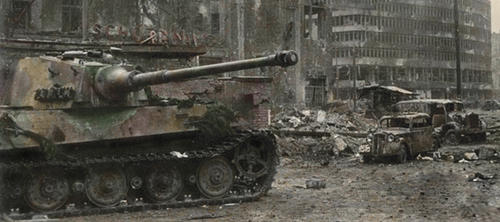A map of the Weidendammer Brücke area. Behind the Panzersperre a tank is drawn. Hitler’s driver Erich Kemka said that he saw Bormann getting blown away when this tank got hit by enemy fire. He thought Bormann was dead, but Kemka was wrong.
At 9.30 p.m., Hamburg radio station warned the German people that a grave and important announcement was about to be made. Suitably funereal music from Wagner and Bruckner’s Seventh Symphony was played to prepare listeners for Grand Admiral Donitz’s address to the nation. He stated that Hitler had fallen, fighting `at the head of his troops’, and announced his succession. Very few people in Berlin heard the news because of the lack of electric current.
Martin Bormann, meanwhile, was evidently impatient at having to wait for the Goebbels family drama to finish. Berlin Commandant General Weidling’s surrender was to take place at midnight and the breakout northwards over the Spree was due to start an hour before. The personnel from the Fuhrer bunker, including Traudl Junge, Gerda Christian and Constanze Manzialy, had been told to assemble ready for departure. Generals’ Krebs and Burgdorf, who both intended to shoot themselves later, were not to be seen.
Krukenberg, who had been summoned earlier by Mohnke, encountered Artur Axmann and Ziegler, the previous commander of the Nordland. Mohnke asked Krukenberg whether, as the senior officer, he wished to continue the defence of the city centre. He added that General Weidling had given an order to break out of Berlin north-westwards through the Soviet encirclement, but that a cease-fire would come into effect around midnight. Krukenberg agreed to join the breakout. He and Ziegler left to rally the Nordland and other units in the area. Krukenberg sent one of his aides on ahead, with messages to outlying detachments to fall back. The group led by Captain Fenet, defending Gestapo headquarters on Prinz-Albrechtstrasse, heard nothing. Krukenberg’s aide, who was never seen again, probably met his death before he reached them.
The scenes in the bunker were chaotic as Bormann and Mohnke tried to organize everybody into groups. In the end, they did not leave until nearly 11 p.m., two hours later than planned. The first group, led by Mohnke, set out through the cellars of the Reich Chancellery, and then followed a complicated route to the Friedrichstrasse Bahnhof. The others followed at set intervals. The most difficult part was just north of the station, where they had to cross the Spree. This could not be done under cover of darkness because the flames from bombarded buildings lit up the whole area. The first group from the Reich Chancellery, which included Mohnke and the secretaries, wisely avoided the main Weidendammer Bridge. They used a metal footbridge 300 metres downstream and headed for the Charite hospital.
The Nordland Tiger tank and a self-propelled assault gun were to spearhead the main charge across the Weidendammer Bridge. Word had spread of the breakout and many hundreds of SS, Wehrmacht soldiers and civilians had assembled. It was a gathering which Soviet troops could not fail to miss. The first mass rush, led by the Tiger tank, took place just after midnight, but although the armoured monster managed to smash through the barrier on the north side of the bridge, they soon ran into very heavy fire in the Ziegelstrasse beyond. An anti-tank round struck the Tiger and many of the civilians and soldiers in its wake were mown down. Axmann was wounded, but managed to stagger on his way. Bormann and Dr Stumpfegger were knocked over by the blast when the tank was hit, but they recovered and went on. Bormann carried the last copy of Hitler’s testament, and he evidently hoped to use it to justify his claim to a position in Donitz’s government when he reached Schleswig-Holstein.
Another attack over the bridge was made soon afterwards, using a self-propelled 20mm quadruple flak gun and a half-track. This too was largely a failure. A third attempt was made at around i a.m., and a fourth an hour later. Bormann, Stumpfegger, Schwaegermann and Axmann kept together for a time. They followed the railway line to the Lehrterstrasse Bahnhof. There they split up. Bormann and Stumpfegger turned north-eastwards towards the Stettiner Bahnhof. Axmann went the other way, but ran into a Soviet patrol. He turned back and followed Bormann’s route. Not long afterwards he came across two bodies. He identified them as Bormann and Stumpfegger, but he did not have time to discover how they had died. Martin Bormann, although not of his own volition, was the only major Nazi Party leader to have faced the bullets of the Bolshevik enemy. All the others – Hitler, Goebbels, Himmler and Goring – took their own lives.
Krukenberg had meanwhile assembled most of his French SS escort. They joined up with Ziegler and a much larger group from the Nordland. Krukenberg estimated that there were four or five holders of the Knight’s Cross among them. They managed to cross the Spree shortly before dawn. But they came under heavy fire just a few hundred metres short of the Gesundbrunnen U-Bahn station. Ziegler was hit by a ricochet and mortally wounded. Several others in their group also fell, among them Eugene Vanlot, the young French recipient of the Knight’s Cross. He died in a nearby cellar three days later.
The Soviet forces in the area had been reinforced so strongly that Krukenberg and his remaining companions had no choice but to retreat the way they had come. At the top end of the Ziegelstrasse they saw the Tiger tank which Mohnke had taken from them. There was no sign of any of its crew. One of Krukenberg’s officers had spotted a joinery workshop nearby and there they discovered some overalls to disguise themselves. Krukenberg managed to make his way to Dahlem, where he hid for over a week in the apartment of friends. Eventually he had no choice but to surrender.
